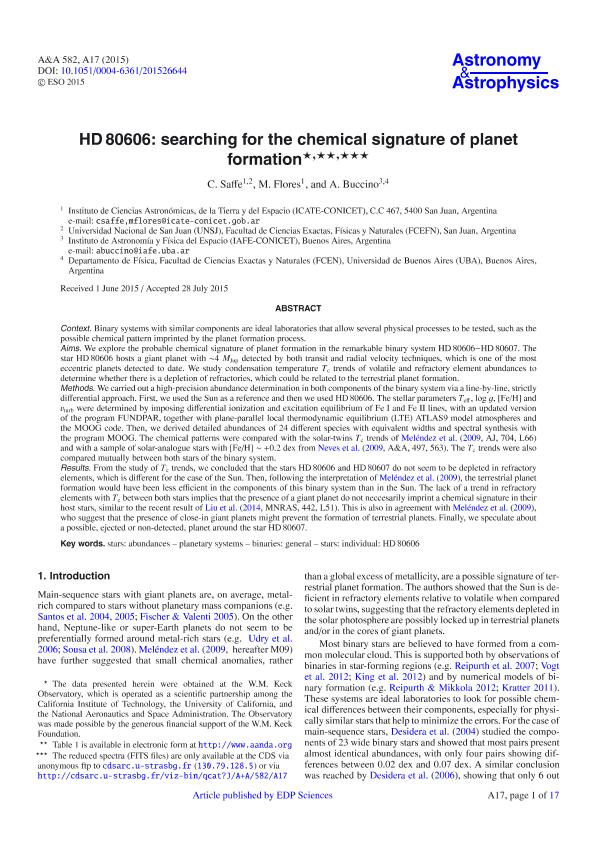Mostrar el registro sencillo del ítem
dc.contributor.author
Saffe, Carlos

dc.contributor.author
Flores Trivigno, Matias Gaston

dc.contributor.author
Buccino, Andrea Paola

dc.date.available
2018-11-12T17:14:51Z
dc.date.issued
2015-10
dc.identifier.citation
Saffe, Carlos; Flores Trivigno, Matias Gaston; Buccino, Andrea Paola; HD 80606: Searching for the chemical signature of planet formation; EDP Sciences; Astronomy and Astrophysics; 582; 10-2015; 17-34
dc.identifier.issn
0004-6361
dc.identifier.uri
http://hdl.handle.net/11336/64252
dc.description.abstract
Context. Binary systems with similar components are ideal laboratories that allow several physical processes to be tested, such as the possible chemical pattern imprinted by the planet formation process. Aims. We explore the probable chemical signature of planet formation in the remarkable binary system HD 80606-HD 80607. The star HD80606 hosts a giant planet with ∼4 MJup detected by both transit and radial velocity techniques, which is one of the most eccentric planets detected to date. We study condensation temperature Tc trends of volatile and refractory element abundances to determine whether there is a depletion of refractories, which could be related to the terrestrial planet formation. Methods. We carried out a high-precision abundance determination in both components of the binary system via a line-by-line, strictly differential approach. First, we used the Sun as a reference and then we used HD80606. The stellar parameters Teff, log g, [Fe/H] and vturb were determined by imposing differential ionization and excitation equilibrium of Fe I and Fe II lines, with an updated version of the program FUNDPAR, together with plane-parallel local thermodynamic equilibrium (LTE) ATLAS9 model atmospheres and the MOOG code. Then, we derived detailed abundances of 24 different species with equivalent widths and spectral synthesis with the program MOOG. The chemical patterns were compared with the solar-twins Tc trends of Meléndez et al. (2009, AJ, 704, L66) and with a sample of solar-analogue stars with [Fe/H] ∼ +0.2 dex from Neves et al. (2009, A&A, 497, 563). The Tc trends were also compared mutually between both stars of the binary system. Results. From the study of Tc trends, we concluded that the stars HD80606 and HD80607 do not seem to be depleted in refractory elements, which is different for the case of the Sun. Then, following the interpretation of Meléndez et al. (2009), the terrestrial planet formation would have been less efficient in the components of this binary system than in the Sun. The lack of a trend in refractory elements with Tc between both stars implies that the presence of a giant planet do not neccesarily imprint a chemical signature in their host stars, similar to the recent result of Liu et al. (2014, MNRAS, 442, L51). This is also in agreement with Meléndez et al. (2009), who suggest that the presence of close-in giant planets might prevent the formation of terrestrial planets. Finally, we speculate about a possible, ejected or non-detected, planet around the star HD80607.
dc.format
application/pdf
dc.language.iso
eng
dc.publisher
EDP Sciences

dc.rights
info:eu-repo/semantics/openAccess
dc.rights.uri
https://creativecommons.org/licenses/by-nc-sa/2.5/ar/
dc.subject
Binaries: General
dc.subject
Planetary Systems
dc.subject
Stars: Abundances
dc.subject
Stars: Individual: Hd 80606
dc.subject.classification
Astronomía

dc.subject.classification
Ciencias Físicas

dc.subject.classification
CIENCIAS NATURALES Y EXACTAS

dc.title
HD 80606: Searching for the chemical signature of planet formation
dc.type
info:eu-repo/semantics/article
dc.type
info:ar-repo/semantics/artículo
dc.type
info:eu-repo/semantics/publishedVersion
dc.date.updated
2018-11-12T13:48:09Z
dc.journal.volume
582
dc.journal.pagination
17-34
dc.journal.pais
Francia

dc.journal.ciudad
Paris
dc.description.fil
Fil: Saffe, Carlos. Consejo Nacional de Investigaciones Científicas y Técnicas. Centro Científico Tecnológico Conicet - San Juan. Instituto de Ciencias Astronómicas, de la Tierra y del Espacio. Universidad Nacional de San Juan. Instituto de Ciencias Astronómicas, de la Tierra y del Espacio; Argentina
dc.description.fil
Fil: Flores Trivigno, Matias Gaston. Consejo Nacional de Investigaciones Científicas y Técnicas. Centro Científico Tecnológico Conicet - San Juan. Instituto de Ciencias Astronómicas, de la Tierra y del Espacio. Universidad Nacional de San Juan. Instituto de Ciencias Astronómicas, de la Tierra y del Espacio; Argentina
dc.description.fil
Fil: Buccino, Andrea Paola. Universidad de Buenos Aires. Facultad de Ciencias Exactas y Naturales. Departamento de Física; Argentina. Consejo Nacional de Investigaciónes Científicas y Técnicas. Oficina de Coordinación Administrativa Ciudad Universitaria. Instituto de Astronomía y Física del Espacio. - Universidad de Buenos Aires. Facultad de Ciencias Exactas y Naturales. Instituto de Astronomía y Física del Espacio; Argentina
dc.journal.title
Astronomy and Astrophysics

dc.relation.alternativeid
info:eu-repo/semantics/altIdentifier/doi/http://dx.doi.org/10.1051/0004-6361/201526644
Archivos asociados
